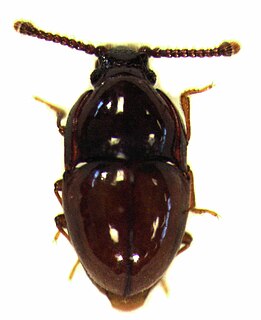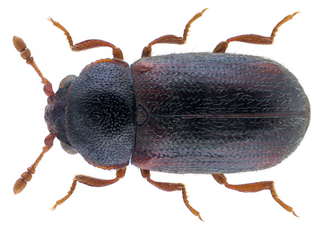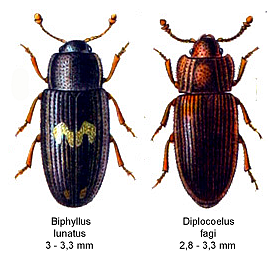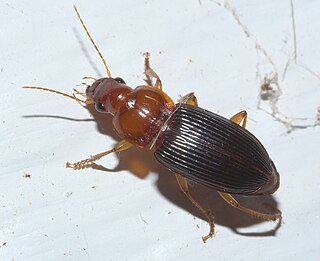
Tiger beetles are a large group of beetles, from the Cicindelinae subfamily, known for their aggressive predatory habits and running speed. The fastest known species of tiger beetle, Cicindela hudsoni, can run at a speed of 9 km/h, or about 125 body lengths per second. As of 2005, about 2,600 species and subspecies were known, with the richest diversity in the Oriental (Indo-Malayan) region, followed by the Neotropics.

Ground beetles are a large, cosmopolitan family of beetles, the Carabidae, with more than 40,000 species worldwide, around 2,000 of which are found in North America and 2,700 in Europe. As of 2015, it is one of the 10 most speciose animal families.

Harpalinae is a huge subfamily of ground beetles that contains 20,000 species or ~6,400 spp. in 24 tribes worldwide, according to others. A rarely used common name for the subfamily is the harp beetles. The Harpalinae contain the most apomorphic ground beetles, displaying a wide range of forms and behaviors. Some are, rare among ground beetles, omnivores or even herbivores.

Dermestidae are a family of Coleoptera that are commonly referred to as skin beetles. Other common names include larder beetle, hide or leather beetles, carpet beetles, and khapra beetles. There are approximately 500 to 700 species worldwide. They can range in size from 1 to 12 mm. Key characteristics for adults are round oval shaped bodies covered in scales or setae. The usually clubbed antennae fit into deep grooves. The hind femora also fit into recesses of the coxa. Larvae are scarabaeiform and also have setae.

Bostrichoidea is a superfamily of beetles. It is the type superfamily of the infraorder Bostrichiformia.

The Lymexylidae, also known as ship-timber beetles, are a family of wood-boring beetles. Lymexylidae belong to the suborder Polyphaga and are the sole member of the superfamily Lymexyloidea.

Staphylinoidea is a superfamily of beetles. It is a very large and diverse group with worldwide distribution.

Ochodaeidae, also known as the sand-loving scarab beetles, is a small family of scarabaeiform beetles occurring in many parts of the world.

Cryptophagidae is a family of beetles with representatives found in all biogeographic realms. Members of this family are commonly called silken fungus beetles and both adults and larvae appear to feed exclusively on fungi although in a wide variety of habitats and situations, such as rotting wood and shed animal fur and feathers. These beetles vary from about 1 to 11 millimeters long, and usually have an oval body shape with a slight "waist".

Calosoma is a genus of large ground beetles that occur primarily throughout the Northern Hemisphere, and are referred to as caterpillar hunters or searchers. Many of the 167 species are largely or entirely black, but some have bright metallic coloration. They produce a foul-smelling spray from glands near the tip of the abdomen. They are recognizable due to their large thorax, which is almost the size of their abdomen and much wider than their head.

Lepturinae, the lepturine beetles, is a subfamily of the longhorn beetle family (Cerambycidae), containing about 150 genera worldwide. This lineage is most diverse in the Northern Hemisphere. Until recently the subfamily Necydalinae was included within the lepturines, but this has been recently recognized as a separate subfamily. Nine tribes are usually recognized today, with a tenth, Caraphiini, created in 2016. A few genera are of uncertain placement within the subfamily.

Melyridae are a family of beetles of the superfamily Cleroidea.

Sphindidae is a family of beetles, in the suborder Polyphaga. Palaeontological discoveries in 2015 have added to the geologic history of Sphindidae, including the discovery of Libanopsis, placed in the extinct subfamily Libanopsinae.

Biphyllidae, or false skin beetles, are a family of beetles, in the suborder Polyphaga. Worldwide, about 195 species are known. They live under the bark of dead trees and feed on fungi. It contains the following genera:

The Mycetophagidae or hairy fungus beetles are a family of beetles in the large suborder Polyphaga. The different species are between 1.0 and 6.5 mm in length. The larvae and adults live in decaying leaf litter, fungi, and under bark. Most species feed on fungi. Worldwide, the 18 genera contain around 200 species.

Trachyderini is a tribe of long-horned beetles in the family Cerambycidae. There are at least 140 genera and 650 described species in Trachyderini.

Pogonocherini is a tribe of longhorn beetles of the subfamily Lamiinae.

Harpalini is a tribe of a diverse group of ground beetles belonging to the subfamily Harpalinae within the broader family Carabidae. The Harpalini tribe contains an estimated 70 genera and subgenera with 357 described species.

Harpalitae is a supertribe of ground beetles in the family Carabidae. There are at least 90 genera and 460 described species in Harpalitae.


















